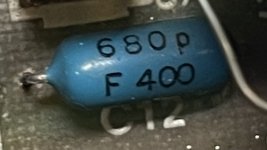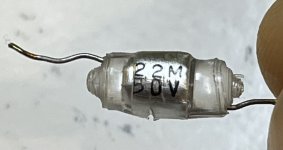Top one is 680pF 1% (F) tolerance, probably a ceramic. The bottom one is 22pF 20% (M) tolerance polystyrene.
As for which has better performance, that depends on the application. Polystyrene is probably the best dielectric for audio purposes but is only available in small values. And for something like RIAA correction that particular polystyrene pictured might not be a great option due to its loose tolerance. Ceramic capacitors can be either excellent or terrible for audio, depending on the type. X7R, Y5V should not be used anywhere in the signal path, but NP0 / C0G types can work very well.
As for which has better performance, that depends on the application. Polystyrene is probably the best dielectric for audio purposes but is only available in small values. And for something like RIAA correction that particular polystyrene pictured might not be a great option due to its loose tolerance. Ceramic capacitors can be either excellent or terrible for audio, depending on the type. X7R, Y5V should not be used anywhere in the signal path, but NP0 / C0G types can work very well.
Fortunately 1 % tolerance ceramic capacitors are always NP0 /C0G or another good (class 1) dielectric. Class 2 (X7R, X5R and so on) capacitors are so unstable that manufacturing them to 1 % initial tolerance would be useless anyway.Ceramic capacitors can be either excellent or terrible for audio, depending on the type. X7R, Y5V should not be used anywhere in the signal path, but NP0 / C0G types can work very well.

